Intel's Haswell Architecture Analyzed: Building a New PC and a New Intel
by Anand Lal Shimpi on October 5, 2012 2:45 AM ESTPlatform Retargeting
Since the introduction of Conroe/Merom back in 2006 Intel has been prioritizing notebooks for the majority of its processor designs. The TDP target for these architectures was set around 35 - 45W. Higher and lower TDPs were hit by binning and scaling voltage. The rule of thumb is a single architecture can efficiently cover an order of magnitude of TDPs. In the case of these architectures we saw them scale all the way up to 130W and all the way down to 17W.

In the middle of 2011 Intel announced its Ultrabook initiative, and at the same time mentioned that Haswell would shift Intel's notebook design target from 35 - 45W down to 10 - 20W.
At the time I didn't think too much about the new design target, but everything makes a lot more sense now. This isn't a "simple" architectural shift, it's a complete rethinking of how Intel approaches platform design. More importantly than Haswell's 10 - 20W design point, is the new expanded SoC design target. I'll get to the second part shortly.
Platform Power
There will be four client focused categories of Haswell, and I can only talk about three of them now. There are the standard voltage desktop parts, the mobile parts and the ultra-mobile parts: Haswell, Haswell M and Haswell U. There's a fourth category of Haswell that may happen but a lot is still up in the air on that line.
Of the three that Intel is talking about now, the first two (Haswell/Haswell M) don't do anything revolutionary on the platform power side. Intel is promising around a 20% reduction in platform power compared to Sandy Bridge, but not the order of magnitude improvement it promised at IDF. These platforms are still two-chip solutions with the SoC and a secondary IO chip similar to what we have today with Ivy Bridge + PCH.
It's the Haswell U/ULT parts that brings about the dramatic change. These will be a single chip solution, with part of the voltage regulation typically found on motherboards moved onto the chip's package instead. There will still be some VR components on the motherboard as far as I can tell, it's the specifics that are lacking at this point (which seems to be much of the theme of this year's IDF).
Seven years ago Intel first demonstrated working silicon with an on-chip North Bridge (now commonplace) and on-package CMOS voltage regulation:
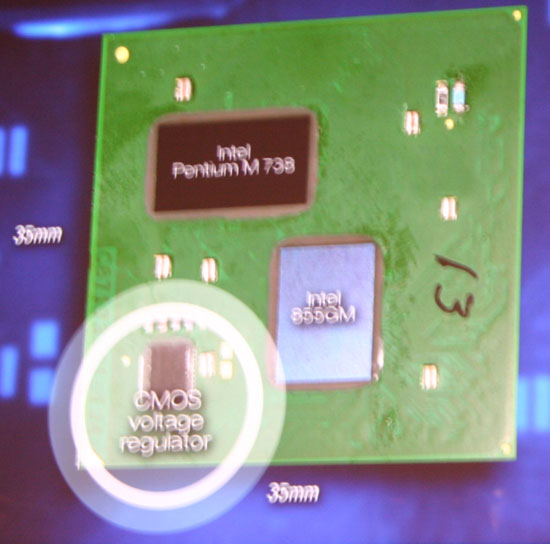
The benefits were two-fold: 1) Intel could manage fine grained voltage regulation with very fast transition times and 2) a tangible reduction in board component count.
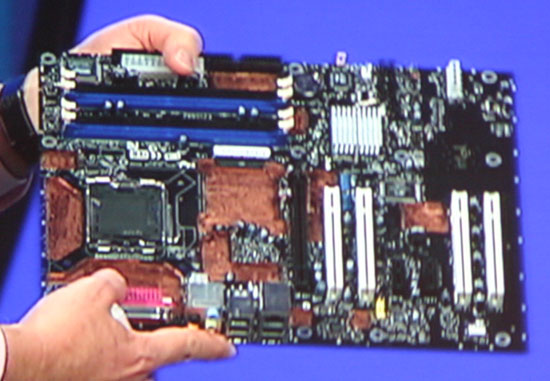
2005 - A prototype motherboard using the technology. Note the lack of voltage regulators on the motherboard and the missing GMCH (North Bridge) chip.
The second benefit is very easy to understand from a mobile perspective. Fewer components on a motherboard means smaller form factors and/or more room for other things (e.g. larger battery volume via a reduction in PCB size).
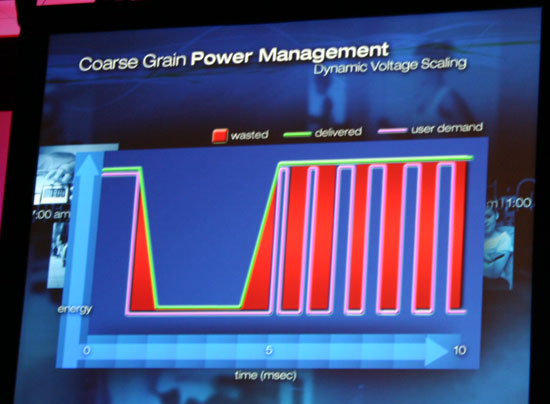

The first benefit made a lot of sense at the time when Intel introduced it, but it makes even more sense when you consider the most dramatic change to Haswell: support for S0ix active idle.


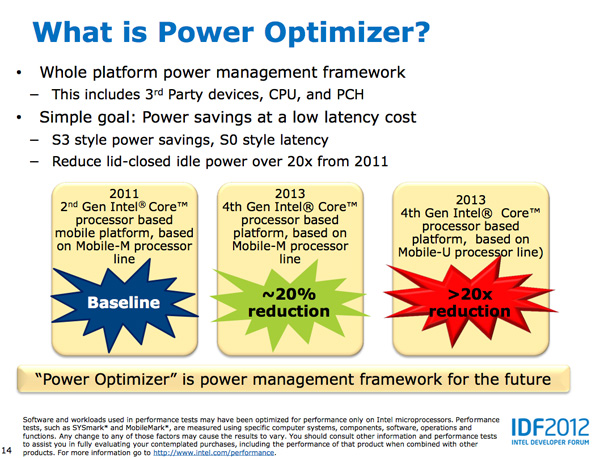
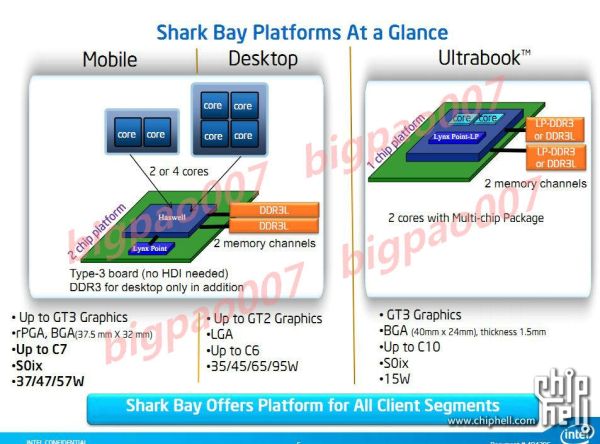








245 Comments
View All Comments
Kepe - Friday, October 5, 2012 - link
Let's see. I think we can agree that the Samsung Galaxy S III was the most important Android phone launch of the summer, so it should get comparable treatment if Anandtech was completely neutral. Let's compare the articles about the SGS III vs. iPhone 5Doing a search on anandtech.com gives us 8 articles/news posts about the SGS III vs. 13 articles/news posts about the iPhone 5.
SGS 3:
Five news stories about product announcements
Performance Preview article
Preview article
Review article
iPhone 5:
Why iPhone 5 isn't launched in 2011 article
Analyzing rumours about iPhone 5 article
New SoC in iPhone 5 article
iPhone 5 Live Blog from the product launch seremony
Three news stories about new features and product announcements
iPhone 5 Hands On article
Lack of simultaneous voice and LTE/EVDO article
Analyzing Geekbench results article
Sunspider Performance Analysis article
Performance Preview article
iPhone 5 Display Thoroughly Analyzed article
+ The upcoming iPhone 5 Review article
+ articles such as "iOS6 Maps Thoroughly Investigated"
Look at the difference. It's quite clear which device gets more coverage. And it's the same thing for older iPhones. Articles such as "Camping out for the new iPhone 3GS".
This is NOT equal treatment of all products. This is why my trust for Anandtech has started to slip. Yes, Anandtech still is the best place for reviews, but one really has to wonder if those reviews still are as neutral and objective as they used to be.
vFunct - Saturday, October 6, 2012 - link
It's an android device. Android devices do not matter. Everyone uses iPhones anyways, They are better. Apple makes better products, including laptops.No need to waste space on Android.
Haugenshero - Saturday, October 6, 2012 - link
Please take your pointless apple fanboy drivel to another site that doesn't care about actual hardware and software and just like shiny things.cjl - Saturday, October 6, 2012 - link
Apple's (iOS) current sales are only 20% of the overall smartphone market share, while Android is over 60%, so if either one of the two is largely irrelevant, it's apple.HisDivineOrder - Sunday, October 7, 2012 - link
Shhhh, icks-nay on the facts-nay.You might cause a fanboy's head to explode near one of those inconveniently placed explosive barrels we walk by in real life.
Just imagine a chain reaction. Caused by an Apple fan's mind being blown. You might take out an entire city block.
Do you want that kind of devastation on your karma? Think different. ;)
vFunct - Sunday, October 7, 2012 - link
The Android market is the cheap giveaways.No one willingly pays money for an Android phone.
Not everyone can afford the premium quality of an Apple product. They will have to settle for an inferior Android devices instead until they can afford higher quality products.
Kepe - Monday, October 8, 2012 - link
Nice trolling there. Now go back under the bridge and stay there =)Old_Fogie_Late_Bloomer - Tuesday, October 9, 2012 - link
"Not everyone can afford the premium quality of an Apple product. They will have to settle for an inferior Android devices instead until they can afford higher quality products."Ha ha ha! Well done, if you're screwing around.
But seriously, if you actually believe that, seek psychiatric help. :-P
Spunjji - Thursday, October 18, 2012 - link
Hahahahahahahahahahahahahahahahahahahahahasolipsism - Tuesday, October 9, 2012 - link
And how many of the 20% is on one phone? Let me know when you figure out how to cover every single Androd-based device that hits the market in a given year.